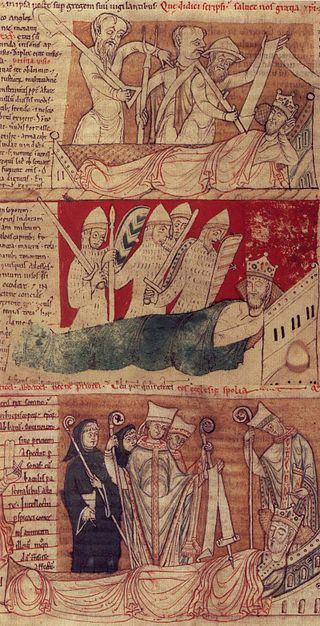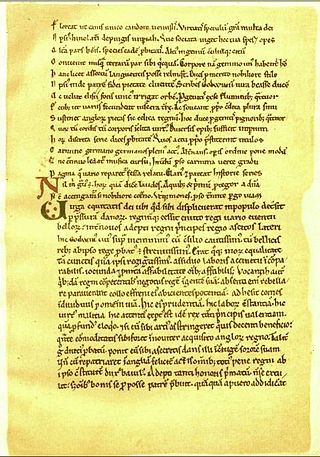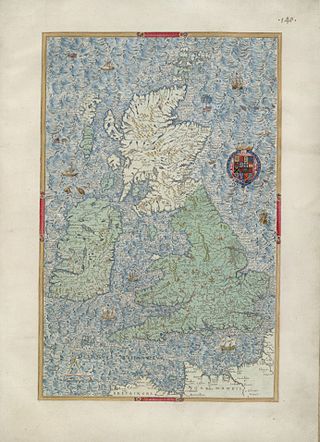Related Research Articles
Florence of Worcester, known in Latin as Florentius, was a monk of Worcester, who played some part in the production of the Chronicon ex chronicis, a Latin world chronicle which begins with the creation and ends in 1140.
Nennius – or Nemnius or Nemnivus – was a Welsh monk of the 9th century. He has traditionally been attributed with the authorship of the Historia Brittonum, based on the prologue affixed to that work. This attribution is widely considered a secondary (10th-century) tradition.
Margaret de Clare, Countess of Gloucester, Countess of Cornwall was an English noblewoman, heiress, and the second eldest of the three daughters of Gilbert de Clare, 6th Earl of Hertford and his wife Joan of Acre, making her a granddaughter of King Edward I of England. Her two husbands were Piers Gaveston and Hugh de Audley, 1st Earl of Gloucester.
Ælfthryth was Queen of the English from her marriage to King Edgar in 964 or 965 until Edgar's death in 975. She was a leading figure in the regency during the minority of her son King Æthelred the Unready between 978 and 984.

Edmund of Woodstock, 1st Earl of Kent, whose seat was Arundel Castle in Sussex, was the sixth son of King Edward I of England, and the second by his second wife Margaret of France, and was a younger half-brother of King Edward II. Edward I had intended to make substantial grants of land to Edmund, but when the king died in 1307, Edward II refused to respect his father's intentions, mainly due to his favouritism towards Piers Gaveston. Edmund remained loyal to his brother, and in 1321 he was created Earl of Kent. He played an important part in Edward's administration as diplomat and military commander and in 1321–22 helped suppress a rebellion.

Hugh Despenser, 1st Baron Despenser, also referred to as "the Younger Despenser", was the son and heir of Hugh Despenser, Earl of Winchester, and his wife Isabel Beauchamp, daughter of William Beauchamp, 9th Earl of Warwick. He rose to national prominence as royal chamberlain and a favourite of Edward II of England. Despenser made many enemies amongst the nobility of England. After the overthrow of Edward, he was eventually charged with high treason and ultimately hanged, drawn and quartered.
Historians in England during the Middle Ages helped to lay the groundwork for modern historical historiography, providing vital accounts of the early history of England, Wales and Normandy, its cultures, and revelations about the historians themselves.
Geoffrey the Baker, also called Walter of Swinbroke, was an English chronicler. He was probably a secular clerk at Swinbrook in Oxfordshire.
Gilbert de Clare, 8th Earl of Gloucester, 7th Earl of Hertford was an English nobleman and military commander in the Scottish Wars. In contrast to most English earls at the time, his main focus lay in the pursuit of war rather than in domestic political strife. He was the son of Gilbert de Clare, 7th Earl of Gloucester, and Joan of Acre, daughter of King Edward I. The older Gilbert died when his son was only four years old, and the younger Gilbert was invested with his earldoms at the young age of sixteen. Almost immediately, he became involved in the defence of the northern border, but later he was drawn into the struggles between Edward II and some of his barons. He was one of the Lords Ordainers who ordered the expulsion of the king's favourite Piers Gaveston in 1311. When Gaveston was killed on his return in 1312, Gloucester helped negotiate a settlement between the perpetrators and the king.

John of Worcester was an English monk and chronicler who worked at Worcester Priory. He is usually held to be the author of the Chronicon ex chronicis.

The Liber Eliensis is a 12th-century English chronicle and history, written in Latin. Composed in three books, it was written at Ely Abbey on the island of Ely in the fenlands of eastern Cambridgeshire. Ely Abbey became the cathedral of a newly formed bishopric in 1109. Traditionally the author of the anonymous work has been given as Richard or Thomas, two monks at Ely, one of whom, Richard, has been identified with an official of the monastery, but some historians hold that neither Richard nor Thomas was the author.
Hemming was a monk, author and compiler in medieval England from around the time of the Norman conquest of England. He was a senior brother at Worcester Cathedral Priory, and his significance derives from the monastic cartulary attributed to him.

The Vita Ædwardi Regis qui apud Westmonasterium Requiescit or simply Vita Ædwardi Regis is a Latin biography of King Edward the Confessor completed by an anonymous author c. 1067 and suspected of having been commissioned by Queen Edith, Edward's wife. It survives in one manuscript, dated c. 1100, now in the British Library. The author is unknown, but was a servant of the queen and probably a Fleming. The most likely candidates are Goscelin and Folcard, monks of St Bertin Abbey in St Omer.
The Historia Ecclesie Abbendonensis or History of the Church of Abingdon was a medieval chronicle written at Abingdon Abbey in England in the 12th century. The Abbey was historically in the county of Berkshire, but since 1974 has been in the county of Oxfordshire.
Noël Denholm-Young was an English historian. He was a Fellow and archivist of Magdalen College, Oxford specialising in the political history of late medieval England. He worked as keeper of Western manuscripts at the Bodleian Library in Oxford, and later in the faculty of the University College of North Wales, Bangor. Among his publications was an edition of the chronicle Vita Edwardi Secundi.
John Walwayn was an English royal official and scholar, and a proposed author of the chronicle known as Vita Edwardi Secundi a partial record of the reign of Edward II.

William Bowyer was an antiquary and government official who was a Member of Parliament and Keeper of the Records in the Tower of London early in the reign of Elizabeth I of England. He was the first Keeper to systematically organise and catalogue the store of government records maintained in the Tower. An avid collector of old manuscripts, he also created Heroica Eulogia, a compilation of grants and verse eulogies relating to the earls of Leicester, along with satirical verses and illustrations, for presentation to Robert Dudley, Earl of Leicester.
The Brut Chronicle, also known as the Prose Brut, is the collective name of a number of medieval chronicles of the history of England. The original Prose Brut was written in Anglo-Norman; it was subsequently translated into Latin and English.
Wendy R. Childs is Emeritus Professor of Later Medieval History at the University of Leeds.
References
- ↑ Denholm-Young, Noël (1969). The Country Gentry in the Fourteenth Century. pp. 39–40.
- ↑ Gransden, Antonia (1982). Historical writing in England ii, c.1307 to the Early Sixteenth Century. pp. 33, 39–40. ISBN 9780710004802.
- ↑ W. R. Childs, ed. (2005). Vita Edwardi Secundi. p. xxiv-xxv. ISBN 0-19-927594-7.
- ↑ Given-Wilson, Chris (1997). "Vita Edwardi Secundi: memoir or journal?". In Prestwich, Michael; Britnell, Richard Hugh; Frame, Robin (eds.). Thirteenth century England VI. Woodbridge: Boydell. pp. 165–76. ISBN 0-85115-674-6.